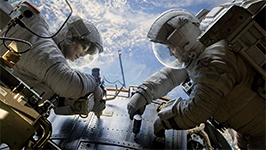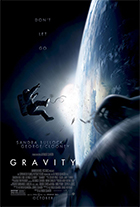Gravity
|  Alfonso Cuarón’s Gravity is nothing if not a technical tour de force, possibly one of the greatest examples in recent years of how far cinematic technology can take us into experiences—both visceral and emotional—that most of us are unlikely to ever encounter. The vast majority of the film takes place in the microgravity environment of the thermosphere, the outermost layer of the Earth’s atmosphere, about 250 miles above the planet’s surface. As the opening title cards suggest, this is an environment far removed from that on Earth—a place of hostile, fluctuating temperatures, no air pressure (and hence no sound), no oxygen (and hence no life). The vastness of the great vacuum in which Earth and the rest of the planets and stars float is simultaneously awe-inspiring and deeply terrifying, which is the exact confluence of clashing emotions that Cuarón’s very nearly great film consistently evokes. We stare in wonder at the vastness of space, at the beauty of the blue-haloed Earth from above, at the seemingly endless expanse of stars beckoning us to worlds light years away that might as well be fantasy, yet at the same time there is a profound sense of emptiness, of loss, of chaos disguised as nothingness. Alfonso Cuarón’s Gravity is nothing if not a technical tour de force, possibly one of the greatest examples in recent years of how far cinematic technology can take us into experiences—both visceral and emotional—that most of us are unlikely to ever encounter. The vast majority of the film takes place in the microgravity environment of the thermosphere, the outermost layer of the Earth’s atmosphere, about 250 miles above the planet’s surface. As the opening title cards suggest, this is an environment far removed from that on Earth—a place of hostile, fluctuating temperatures, no air pressure (and hence no sound), no oxygen (and hence no life). The vastness of the great vacuum in which Earth and the rest of the planets and stars float is simultaneously awe-inspiring and deeply terrifying, which is the exact confluence of clashing emotions that Cuarón’s very nearly great film consistently evokes. We stare in wonder at the vastness of space, at the beauty of the blue-haloed Earth from above, at the seemingly endless expanse of stars beckoning us to worlds light years away that might as well be fantasy, yet at the same time there is a profound sense of emptiness, of loss, of chaos disguised as nothingness.The film’s bravura opening shot, which lasts a full 17 minutes, establishes the film’s aesthetic ambitions with its vertiginous, seemingly unbroken capturing of both the pleasures and the dangers of floating in a vacuum devoid of gravity, as well as the two central characters: Matt Kowalski (George Clooney), a veteran astronaut on his last mission into space, and Dr. Ryan Stone (Sandra Bullock), a medical engineer making her first trip into space in order to install a piece of technology she invented on the international space station. The dialogue during this shot, which also includes radio transmissions from NASA (Mission Control is voiced by Ed Harris, who played a similar role in Ron Howard’s Apollo 13), mixes a great deal of technical jargon with subtle insights into the characters: Matt’s easygoing jocularity and Ryan’s nervous determination. He’s the old pro, she’s the newbie, and the parameters of that relationship are put into stark relief when they are faced with sudden, unavoidable catastrophe: An orbiting satellite that was detonated by the Russians has sent a field of debris hurtling toward them at astronomical speeds, putting everyone’s life in imminent danger. There is no time to escape the debris (one thing about being in space is that you are largely at the mercy of your orbit), and it hits the station with great force, ripping it to shreds and killing everyone except Matt and Ryan. The rest of the film details their desperate attempt to survive a seemingly never-ending cascade of threats: lack of oxygen, dwindling rocket power, a fire that breaks out on another space station on which they find temporary safe haven, and so on. Cuarón, who scripted along with his son Jonás, keeps the characters in perpetual danger, such that the moments when they do seem safe are still fraught with tension because we’re waiting for the next catastrophe to strike. The film is structured in a tight, concise 90 minutes, and while that doesn’t give a lot of room for character development, Bullock and Clooney are impressive in their abilities to generate a passable sense of depth to Ryan and Matt. Bullock, in particular, is given a demanding role in that much of the danger falls on her shoulders, and each narrow escape doesn’t so much build her confidence as it strengthens her realization (and ours) of just how fragile life is, especially in an alien environment that is fundamentally antithetical to survival. From maintaining body temperature, to filling her lungs with air, to halting a perpetual drift into the void of space, Ryan’s survival relies entirely on human-created technology that may or may not work (and of which she may or may not have a full working knowledge). When her demise seems imminent and she reflects on her desire to pray, but inability to do having never been taught how, it strikes us as a deeply personal moment of self-realization—the inherent spirituality of existence running headlong into the horrors of physical limitations. Bullock creates a character who reveals an impressive inner strength while also conveying a consistent sense of vulnerability: She is often afraid and panicky, but it isn’t another example of Hollywood’s casual misogyny, but rather a reasonable and imminently recognizable response to a dire situation. Her survival requires that she conquer the very environment around her, which becomes the film’s overriding motif and gives weight (pardon the pun) to all the special effects around her. And special the effects are. While astrophysicists and veteran astronauts are already having a field day nitpicking the scientific details of Gravity, Cuarón should be congratulated for creating a film that feels entirely convincing. Like 2001: A Space Odyssey (1968), Stanley Kubrick’s philosophical sci-fi masterpiece, Gravity is a film that demands presence on the largest screen possible so that we can be fully immersed in the same world as the characters. That, however, is largely where comparisons of the two films should stop, as Cuarón has an entirely different narrative and philosophical agenda to work out. Gravity is first and foremost a survival tale, an old-fashioned adventure parable set in space, rather than in the desert or forest or jungle. It pits human ingenuity and tenacity against the cold, emotionless realities of physics, and in that tension finds a reason to celebrate humanity. Cuarón isn’t making an argument for humankind’s relationship to the cosmos or speculating of “the grand meaning” of it all, but rather pointing our attention to the human will to survive and how that can be just as beautiful and terrifying as any spacescape. Copyright ©2013 James Kendrick Thoughts? E-mail James Kendrick All images copyright © Warner Bros. |
Overall Rating: 


 (3.5)
(3.5)


